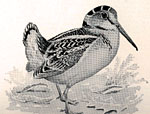By Mary Losure
Minnesota Public Radio
May 19, 2002
For most of the year, a peculiar little bird known as the American Woodcock lives hidden on the forest floor, camouflaged among dry leaves. But for a few weeks in the springtime, the male woodcock emerges from obscurity. As dark falls, he gives an odd, buzzing call, then launches himself skyward for a spectacular courting flight.
| |
|
|
|
||
Most people have never seen a woodcock, but they're a plump, little bird with huge eyes and a very long bill. The woodcock's bill is specially designed to catch worms beneath the damp forest floor; the tip can open, even when its plunged deep in the earth.
The bird's big eyes are set far back in its head, so it can keep watch for predators while it feeds. The woodcock's strange eating habits have earned it the nickname "bog sucker," but it has many others - big eyes, peewee, night peck, big mud snipe, and even hookum pake. Many people call woodcocks timberdoodles.
Timberdoodles are tasty; they're a popular game bird. Their biggest fans are hunters, whose dogs can spot the birds much more easily than people can.
"When I was a little kid, and didn't have a car, and I wanted to go hunting, I would walk about three miles to a wildlife area near our house, and that's where I shot my first woodcock," recalls Jim Kelley, who coordinates woodcock preservation efforts for the US Fish and Wildlife Service.
We have come here, to a back road along the Saint Croix River, hoping for another sort of encounter. Just outside the car window lies a singing ground for timberdoodles.
A cluster of young pines provides cover in an open, grassy field bordered by young hardwood forest; the kind timberdoodles like. Unfortunately, it's raining. Unless it lets up, the chances of a timberdoodle flight are slim.
While we wait, we talk about timberdoodle population trends, which are also discouraging. The US Fish and Wildlife Service and others have been counting woodcocks on singing grounds since 1968. The counts have declined each year by around two percent, across the woodcocks range. That's the eastern half of the United States and parts of eastern Canada.
| |
|
|
|
||
The culprit is thought to be loss of habitat, not pressure from hunting. Still, the service has shortened the woodcock season and reduced bag limits, and Kelley says some hunters are voluntarily cutting back.
"You hear some hunters that say they still encounter large numbers of birds every fall. I get letters from other hunters who say 'I've probably shot my last woodcock, because I don't think I should be hunting them anymore,'" Kelley says.
Kelley and other woodcock biologists are working with government and private interests to restore woodcock habitat, and with it, the woodcock. But he believes those efforts would be strengthened if the general public knew more about the bird.
So he offers some tips for woodcock spotting: On a spring evening, go to a place that meets the woodcock's requirements for a singing ground - open space, light cover, and nearby young forest. Just as dark is falling, listen for their peculiar call.
"I'll bet you most people would think it's an insect. It just doesn't even sound like a bird, except when they're up in the air doing their display. But when they're on the ground doing what we call the 'peent call,' it doesn't even sound like a bird," Kelley says.
The rain has let up , so we get out and listen. "Hear that? He's right in that little patch over there," says Kelley, grinning widely, as if hearing a timberdoodle for the first time.
Suddenly a dark shape shoots into the air like a cannonball with feathers. There's a flutter of wings, and a faint high twittering. Three-hundred feet above the ground, a timberdoodle makes vast circles in the sky, fluttering like a bat, a tiny black shape careening below the rain clouds. Then he plummets to earth, and prepares for another flight.
In the nearby woods, the female timberdoodles he's hoping to attract to his singing grounds are listening.
The bird is too far away for us to see clearly, but Kelley has a method for getting closer. He knows a timberdoodle will usually land at the same place from which he took off. "So you watch that spot , then you sneak toward it when he's in the air again," he says. "Sneak closer with each flight, and if you're lucky, you can get within a few feet of a singing timberdoodle."
In the growing dark, he's a portly, little figure with a ridiculously long beak. He stands uncertainly on the grass, calling into the night. He lives his life mostly unnoticed, just out of sight of the busy world.
Go out some spring evening, play a wild game of hide and seek, and maybe you'll see him, standing earthbound for a little while, before he spirals into the sky.


